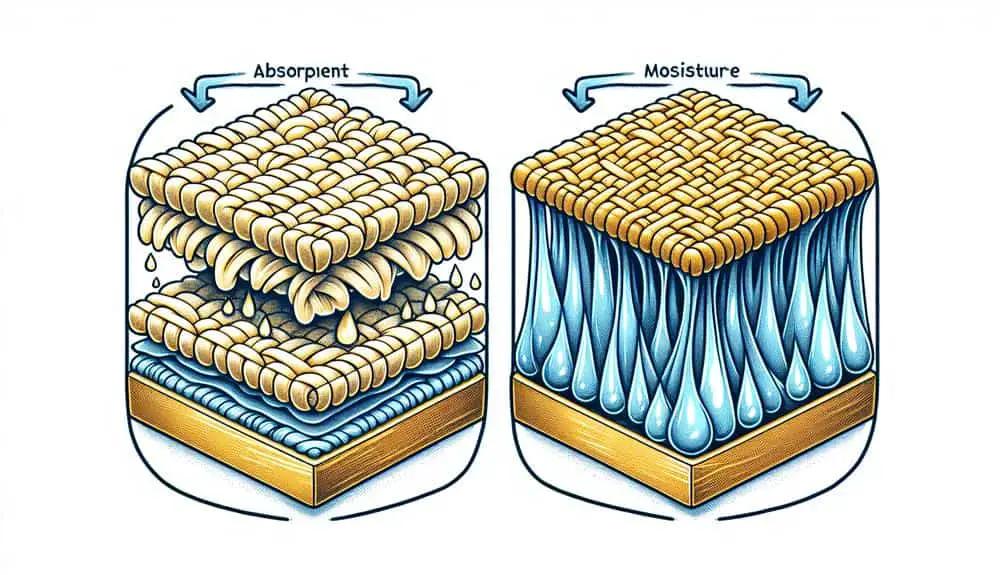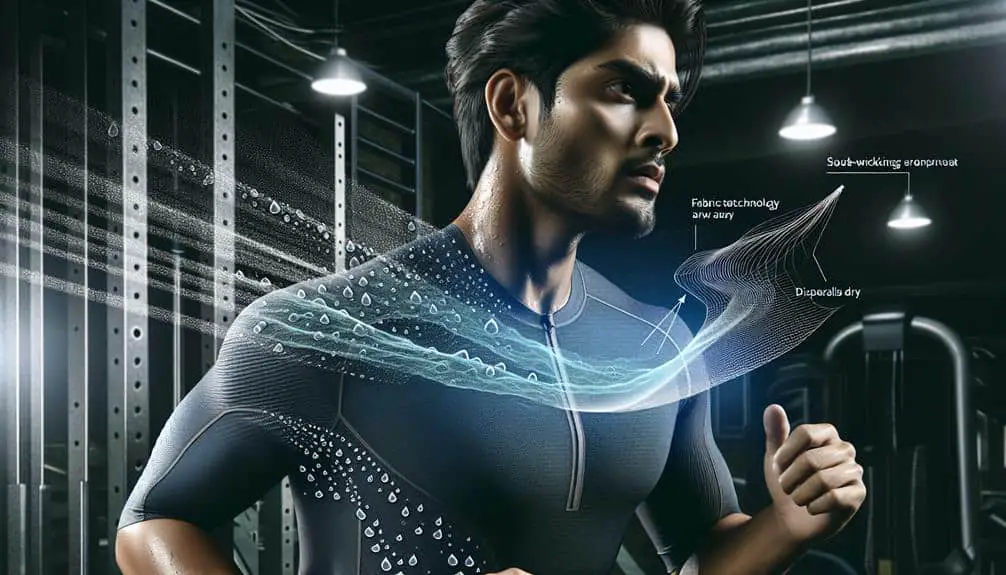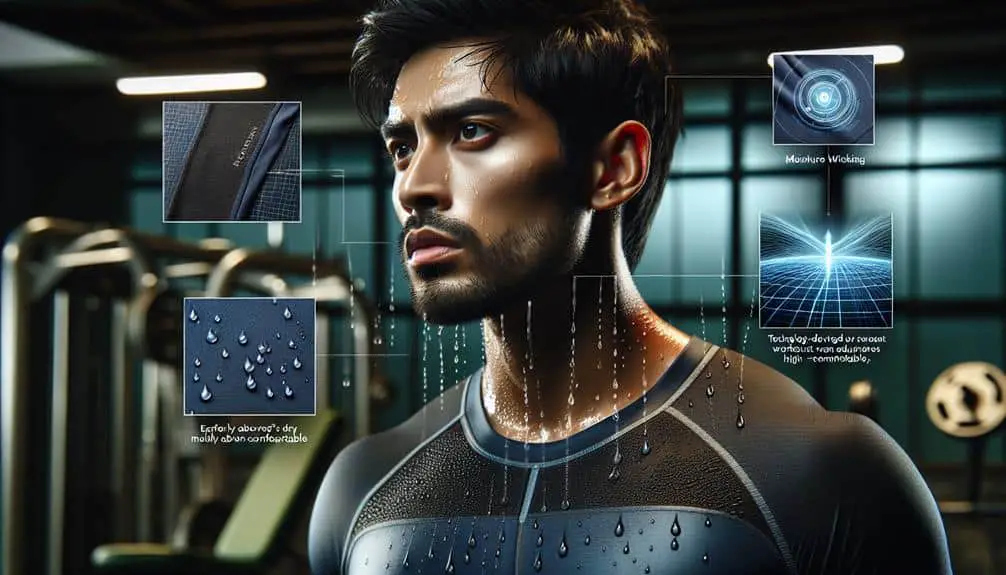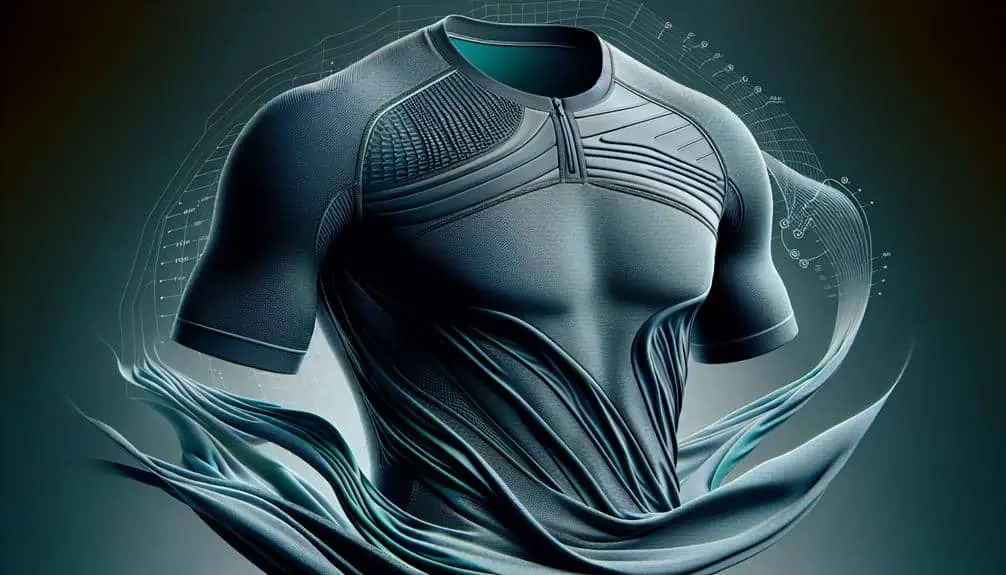When choosing fabrics for moisture control, opt for ones that efficiently pull moisture away from your skin. Technology advancements have made synthetic fibers water-repellent for better sweat management. Look for fabrics with small gaps that allow moisture to easily pass through so it can evaporate. These fabrics spread moisture out on the outer layer, maximizing evaporation. This helps regulate body temperature during activities. Fabrics with moisture-wicking finishes are great for this purpose. Keep in mind breathability, absorption, and durability when selecting fabrics. Fabrics like nylon or polyester blends work well. Care for them following specific washing guidelines.
Key Points
- Prioritize fabrics with moisture-wicking technology for efficient sweat management.
- Look for fabrics that allow moisture to evaporate quickly to keep you dry and comfortable.
- Choose materials with high breathability to aid in moisture evaporation during physical activities.
- Opt for durable fabrics like nylon or polyester blends for long-lasting moisture control.
- Consider fabrics with moisture-wicking finishes to effectively manage sweat during workouts.
Moisture-Wicking Fabric Technology
When selecting moisture-wicking fabrics, prioritize those engineered to efficiently draw moisture away from the skin. Fabric technology advancements have greatly improved sweat management strategies in sportswear and activewear. The key lies in the composition of the fabric itself. Modern moisture-wicking fabrics utilize advanced synthetic fibers that are water-repellent, meaning they repel water. These fibers are engineered to have small gaps between them, allowing moisture to pass through easily. Once the moisture reaches the outer layer of the fabric, it spreads out, maximizing surface area for evaporation.
The design of these fabrics plays an important role in their performance. Fabrics with a combination of water-attracting and water-repelling fibers make sure that moisture is quickly pulled away from the skin and dispersed throughout the material. This aids in the evaporation process, keeping you dry and comfortable during physical activities. By understanding the intricacies of fabric technology advancements and sweat management strategies, you can make informed decisions when choosing the right moisture-wicking fabric for your needs.
Benefits of Moisture-Wicking Materials
Moisture-wicking materials offer enhanced comfort and performance by efficiently managing sweat during physical activities. These fabrics excel in sweat absorption, pulling moisture away from your skin and dispersing it across a larger surface area for quicker evaporation. This process helps regulate your body temperature, keeping you cool and dry during intense workouts or hot weather conditions.
One of the key benefits of moisture-wicking materials is their ability to keep you dry by allowing sweat to evaporate rapidly. Unlike traditional fabrics that trap moisture, moisture-wicking materials are designed to be breathable, allowing air to circulate and enhance the evaporation process. This feature is particularly advantageous during high-intensity exercises or in humid environments.
Performance Comparison: Wicking Vs Regular
For a precise comparison of performance between moisture-wicking and regular fabrics, assess their moisture management capabilities under varying conditions. Wicking fabric properties are designed to actively pull moisture away from the skin and disperse it across a larger surface area, allowing for quicker evaporation. This process helps regulate body temperature and keeps you dry during physical activities.
In contrast, regular fabrics, lacking wicking properties, tend to trap moisture next to the skin, leading to discomfort, chafing, and potential odor buildup. When comparing the two, wicking fabrics excel in moisture management, keeping you more comfortable and dry. Regular fabrics, on the other hand, have limitations in efficiently handling moisture, especially during intense workouts or in hot and humid environments.
Factors to Consider in Fabric Selection
Consider key fabric properties such as breathability, moisture absorption, and durability when selecting the most suitable material for your moisture control needs.
Breathability refers to the fabric's ability to allow air to pass through, aiding in moisture evaporation and keeping you comfortable during physical activities. Fabrics with high breathability, such as certain types of polyester and merino wool, are ideal for moisture control as they help regulate body temperature.
Durability is vital for ensuring the fabric withstands frequent use and wash cycles without losing its moisture-wicking properties. Look for fabrics like nylon or polyester blends known for their durability in activewear.
Evaluating the fabric's construction and weave can also provide insight into its moisture control capabilities. Fabrics with moisture-wicking finishes or treatments can enhance their ability to pull moisture away from the skin. Prioritize these factors when choosing fabrics to effectively manage moisture during your activities while ensuring longevity and comfort.
Care and Maintenance Tips for Wicking Fabrics
How can you guarantee the longevity and effectiveness of wicking fabrics through proper care and maintenance? To make sure your wicking fabrics continue to perform at their best, follow these essential care and maintenance tips:
- Washing Instructions: Always consult the garment's care label for specific washing guidelines. Generally, it's recommended to wash wicking fabrics in cold water on a gentle cycle to prevent damage to the fabric's moisture-wicking properties. Avoid using fabric softeners as they can clog the fabric's pores, reducing its ability to wick moisture effectively.
- Drying Techniques: Air drying wicking fabrics is the best way to preserve their moisture-wicking capabilities. If you must use a dryer, opt for a low heat setting to prevent damage to the fabric fibers. Avoid using dryer sheets as they can leave a residue on the fabric, inhibiting its moisture-wicking properties.
- Storage: Store your wicking fabrics in a cool, dry place away from direct sunlight to prevent mold and mildew growth. Avoid storing them in plastic bags or containers as they can trap moisture, leading to odors and potential fabric damage over time.
Frequently Asked Questions
Can Moisture-Wicking Fabrics Help Prevent Body Odor Caused by Sweat?
When you sweat, bacteria on your skin break down sweat into compounds that cause odor. Moisture-wicking fabrics draw sweat away from your skin, reducing the breeding ground for bacteria, which helps prevent body odor.
Are There Any Environmental Implications to Consider When Choosing Moisture-Wicking Fabrics?
When choosing moisture-wicking fabrics, consider environmental sustainability. Fabric production impacts ecosystems and resources. Opt for materials made through eco-friendly processes like recycled polyester or organic cotton to minimize environmental implications associated with moisture-wicking fabrics.
Can Moisture-Wicking Fabrics Help Regulate Body Temperature in Different Climates?
In different climates, moisture-wicking fabrics excel at regulating body temperature. They enhance heat retention in cooler regions while ensuring breathability in warmer environments. Sweat absorption capabilities of these fabrics contribute to overall comfort regardless of the weather.
Do Moisture-Wicking Fabrics Have Any Impact on the Overall Durability of the Garment?
Moisture-wicking fabrics can improve fabric performance by managing sweat, but they may impact the longevity of the garment. The constant pulling of moisture can strain fibers, potentially affecting durability over time.
Are There Specific Activities or Sports Where Moisture-Wicking Fabrics Are More Beneficial Than Others?
Engage in athletic activities where breathability is key for peak athletic performance and comfort. Select materials that support moisture control to excel in sports like running, cycling, and hiking. Elevate your game effortlessly.



